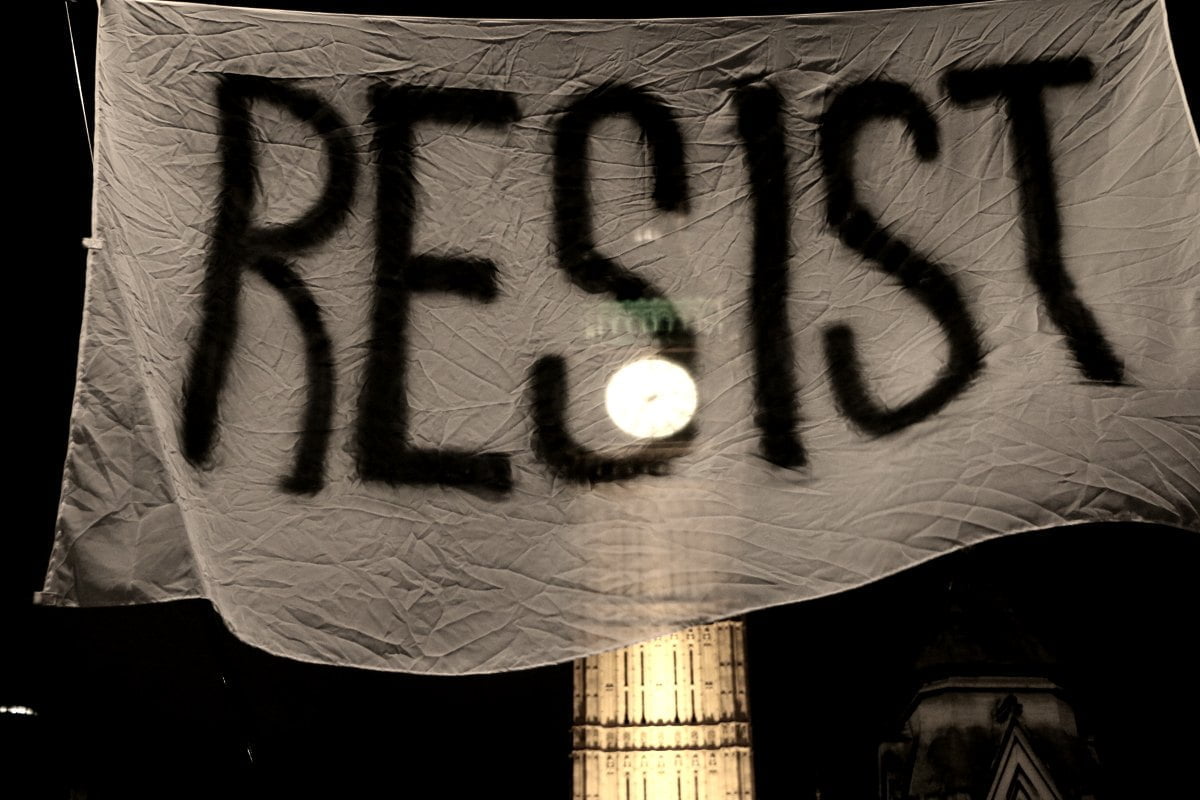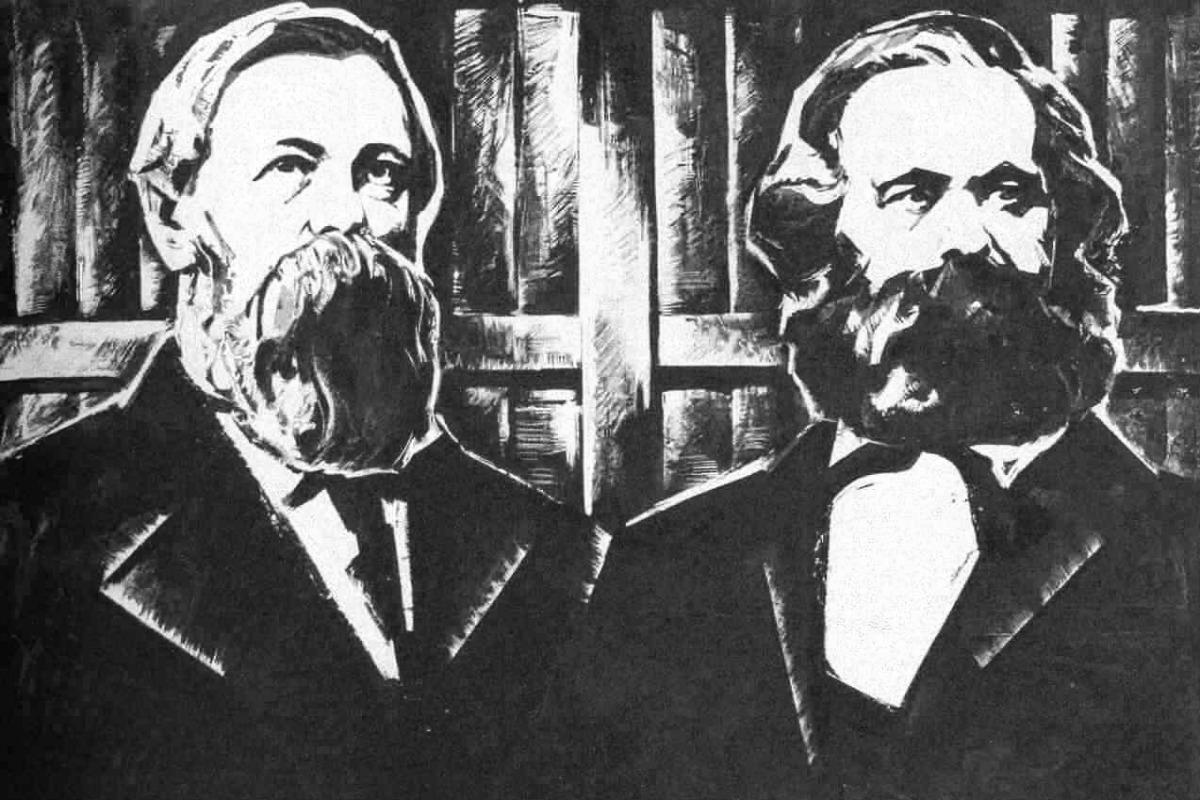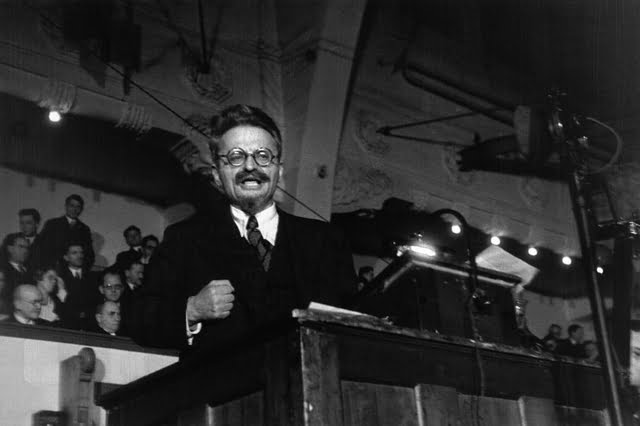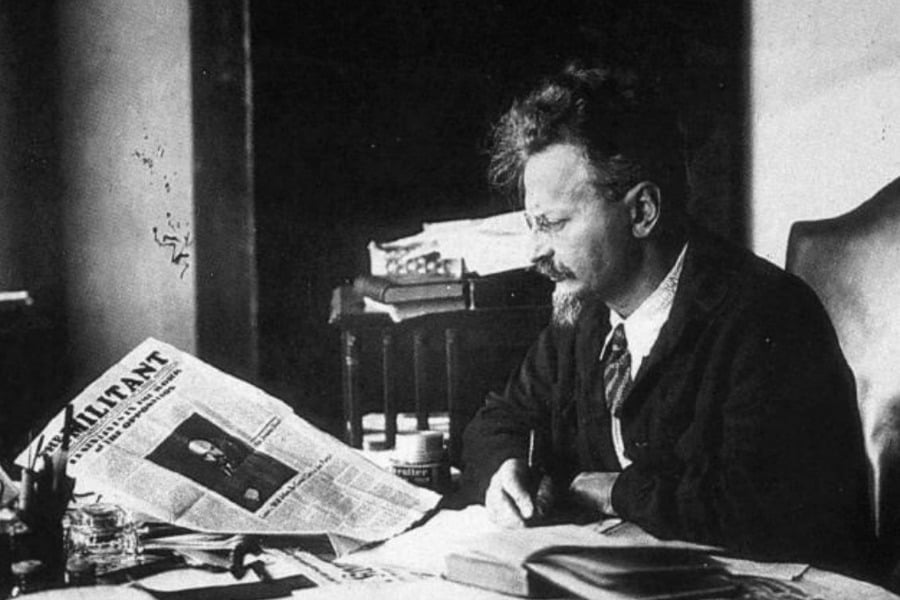The publication of The Communist Manifesto, written on 21st February 1848 by Karl Marx and Frederick Engels for the Communist League, ushered onto the stage of history one of the most important and revolutionary texts ever to be produced.
This short pamphlet has – over the following 170 years – been published and republished around the world in a multitude of various languages and editions. Its opening sentence, “A spectre is haunting Europe – the spectre of communism”, is as well known today as it was in Marx’s time.
What may seem astonishing to capitalist commentators is that the words of the Manifesto seem, if anything, more relevant today than ever. In these words from long ago, it is possible to see both an explanation of why the world is as it is and also that there is an alternative – socialism. The task is to fight for it.
The ideas of the Communist Manifesto, of Marxism, are living ideas that both inspire and educate. As Marx famously put it: “The philosophers have only interpreted the world, in various ways. The point, however, is to change it.”
Class struggle
This pamphlet, displaying greater genius than any other in world literature, astounds us even today by its freshness. Its most important sections appear to have been written yesterday. Assuredly, the young authors (Marx was twenty-nine, Engels twenty-seven) were able to look further into the future than anyone before them, and perhaps than anyone since them.
The materialist conception of history, discovered by Marx only a short while before and applied with consummate skill in the Manifesto, has completely withstood the test of events and the blows of hostile criticism. It constitutes today one of the most precious instruments of human thought. All other interpretations of the historical process have lost all scientific meaning. We can state with certainty that it is impossible in our time to be not only a revolutionary militant but even a literate observer in politics without assimilating the materialist interpretation of history.
The first chapter of the Manifesto opens with the following words: “The history of all hitherto existing society is the history of class struggles.”
This postulate, the most important conclusion drawn from the materialist interpretation of history, immediately became an issue in the class struggle. Especially venomous attacks were directed by reactionary hypocrites, liberal doctrinaires and idealistic democrats against the theory which substituted the struggle of material interests for “common welfare,” “national unity” and “eternal moral truths” as the driving force of history. They were later joined by recruits from the ranks of the labour movement itself, by the so-called revisionists, i.e., the proponents of reviewing (“revising”) Marxism in the spirit of class collaboration and class conciliation.
Finally, in our own time, the same path has been followed in practice by the contemptible epigones of the Communist International (the “Stalinists”): the policy of the so-called People’s Front flows wholly from the denial of the laws of the class struggle. Meanwhile, it is precisely the epoch of imperialism, bringing all social contradictions to the point of highest tension, which gives to the Communist Manifesto its supreme theoretical triumph.
Immiseration
The anatomy of capitalism, as a specific stage in the economic development of society, was given by Marx in its finished form in Capital (1867). But even in the Communist Manifesto the main lines of the future analysis are firmly sketched: the payment for labour power as equivalent to the cost of its reproduction; the appropriation of surplus value by the capitalists; competition as the basic law of social relations; the ruination of intermediate classes, i.e., the urban petty bourgeoisie and the peasantry; the concentration of wealth in the hands of an ever-diminishing number of property owners, at the one pole, and the numerical growth of the proletariat, at the other; the preparation of the material and political preconditions for the socialist regime.
The proposition in the Manifesto concerning the tendency of capitalism to lower the living standards of the workers, and even to transform them into paupers, had been subjected to a heavy barrage. Parsons, professors, ministers, journalists, Social Democratic theoreticians, and trade union leaders came to the front against the so-called “theory of impoverishment”. They invariably discovered signs of growing prosperity among the toilers, palming off the labour aristocracy as the proletariat, or taking a fleeting tendency as permanent.
Meanwhile, even the development of the mightiest capitalism in the world, namely, US capitalism, has transformed millions of workers into paupers who are maintained at the expense of federal, municipal, or private charity.
As against the Manifesto, which depicted commercial and industrial crises as a series of ever more extensive catastrophes, the revisionists vowed that the national and international development of trusts would assure control over the market and lead gradually to the abolition of crises. The close of the last century and the beginning of the present one were in reality marked by a development of capitalism so tempestuous as to make crises seem only “accidental” stoppages. But this epoch has gone beyond return. In the last analysis, truth proved to be on Marx’s side in this question as well.
The state and revolution
 “The executive of the modern state is but a committee for managing the common affairs of the whole bourgeoisie.” This succinct formula, which the leaders of the Social Democracy looked upon as a journalistic paradox, contains in fact the only scientific theory of the state.
“The executive of the modern state is but a committee for managing the common affairs of the whole bourgeoisie.” This succinct formula, which the leaders of the Social Democracy looked upon as a journalistic paradox, contains in fact the only scientific theory of the state.
The democracy fashioned by the bourgeoisie is not, as both Bernstein and Kautsky thought, an empty sack which one can undisturbedly fill with any kind of class content. Bourgeois democracy can serve only the bourgeoisie. A government of the “People’s Front,” whether headed by Blum or Chautemps, Caballero or Negrin, is only “a committee for managing the common affairs of the whole bourgeoisie.” Whenever this “committee” manages affairs poorly, the bourgeoisie dismisses it with a boot.
“Every class struggle is a political struggle.” “The organisation of the proletariat as a class [is] consequently its organisation into a political party.” Trade unionists, on the one hand, and anarcho-syndicalists, on the other, have long shied away – and even now try to shy away – from the understanding of these historical laws. “Pure” trade unionism has now been dealt a crushing blow in its chief refuge: the United States. Anarcho-syndicalism has suffered an irreparable defeat in its last stronghold – Spain. Here too the Manifesto proved correct.
The proletariat cannot conquer power within the legal framework established by the bourgeoisie. “Communists openly declare that their ends can be attained only by the forcible overthrow of all existing social conditions.”
Reformism sought to explain this postulate of the Manifesto on the grounds of the immaturity of the movement at that time, and the inadequate development of democracy. The fate of Italian, German, and a great number of other “democracies” proves that “immaturity” is the distinguishing trait of the ideas of the reformists themselves.
For the socialist transformation of society, the working class must concentrate in its hands such power as can smash each and every political obstacle barring the road to the new system. “The proletariat organised as the ruling class” – this is the dictatorship.
At the same time it is the only true proletarian democracy. Its scope and depth depend upon concrete historical conditions. The greater the number of states that take the path of the socialist revolution, the freer and more flexible forms will the dictatorship assume, the broader and more deep going will be workers’ democracy.
Workers of the world: unite!
 The international development of capitalism has predetermined the international character of the proletarian revolution. “United action, of the leading civilized countries at least, is one of the first conditions for the emancipation of the proletariat.” The subsequent development of capitalism has so closely knit all sections of our planet, both “civilized” and “uncivilized”, that the problem of the socialist revolution has completely and decisively assumed a world character.
The international development of capitalism has predetermined the international character of the proletarian revolution. “United action, of the leading civilized countries at least, is one of the first conditions for the emancipation of the proletariat.” The subsequent development of capitalism has so closely knit all sections of our planet, both “civilized” and “uncivilized”, that the problem of the socialist revolution has completely and decisively assumed a world character.
The Soviet bureaucracy attempted to liquidate the Manifesto with respect to this fundamental question. The Bonapartist degeneration of the Soviet state is an overwhelming illustration of the falseness of the theory of socialism in one country.
“When, in the course of development, class distinctions have disappeared, and all production has been concentrated in the hands of a vast association of the whole nation, the public power will lose its political character.” In other words: the state withers away. Society remains, freed from the straitjacket. This is nothing else but socialism. The converse theorem: the monstrous growth of state coercion in the USSR is eloquent testimony that society is moving away from socialism.
“The workingmen have no fatherland.” These words of the Manifesto have more than once been evaluated by philistines as an agitational quip. As a matter of fact they provided the proletariat with the sole conceivable directive in the question of the capitalist “fatherland”.
The violation of this directive by the Second International brought about not only four years of devastation in Europe, but the present stagnation of world culture. In view of the impending new war, for which the betrayal of the Third International has paved the way, the Manifesto remains even now the most reliable counselor on the question of the capitalist “fatherland”.
Standing the test of time
 Thus, we see that the joint and rather brief production of two young authors continues to give irreplaceable directives upon the most important and burning questions of the struggle for emancipation. What other book could even distantly be compared with the Communist Manifesto?
Thus, we see that the joint and rather brief production of two young authors continues to give irreplaceable directives upon the most important and burning questions of the struggle for emancipation. What other book could even distantly be compared with the Communist Manifesto?
But this does not imply that after ninety years of unprecedented development of productive forces and vast social struggles, the Manifesto needs neither corrections or additions. Revolutionary thought has nothing in common with idol-worship. Programmes and prognoses are tested and corrected in the light of experience, which is the supreme criterion of human reason.
The Manifesto, too, requires corrections and additions. However, as is evidenced by historical experience itself, these corrections and additions can be successfully made only by proceeding in accord with the method lodged in the foundation of the Manifesto itself. We shall try to indicate this in several most important instances.
Marx taught that no social system departs from the arena of history before exhausting its creative potentialities. The Manifesto excoriates capitalism for retarding the development of the productive forces.
During that period, however, as well as in the following decades, this retardation was only relative in nature. Had it been possible in the second half of the nineteenth century to organise the economy on socialist [grounds], its tempos of growth would have been immeasurably greater.
But this theoretically irrefutable postulate does not invalidate the fact that the productive forces kept expanding on a world scale right up to the world war. Only in the last twenty years, despite the most modern conquests of science and technology, has the epoch of out-and-out stagnation and even decline of world economy begun. Mankind is beginning to expend its accumulated capital, while the next war threatens to destroy the very foundations of civilisation for many years to come.
The authors of the Manifesto thought that capitalism would be scrapped long [before] the time when from a relatively reactionary regime it would turn into an absolutely reactionary regime. This transformation took final shape only before the eyes of the present generation and changed our epoch into the epoch of wars, revolutions, and fascism.
The error of Marx and Engels in regard to the historical dates flowed, on the one hand, from an underestimation of future possibilities latent in capitalism and, on the other, an overestimation of the revolutionary maturity of the proletariat. The revolution of 1848 did not turn into a socialist revolution as the Manifesto had calculated but opened up to Germany the possibility of a vast future capitalist ascension.
The Paris Commune proved that the proletariat, without having a tempered revolutionary party at its head, cannot wrest power from the bourgeoisie. Meanwhile, the prolonged period of capitalist prosperity that ensued brought about not the education of the revolutionary vanguard, but rather the bourgeois degeneration of the labour aristocracy, which became in turn the chief brake on the proletarian revolution. In the nature of things, the authors of the Manifesto could not possibly have foreseen this “dialectic”.
Monopoly and imperialism
 For the Manifesto, capitalism was the kingdom of free competition. While referring to the growing concentration of capital, the Manifesto did not draw the necessary conclusion in regard to monopoly, which has become the dominant capitalist form in our epoch and the most important precondition for socialist economy. Only afterwards, in Capital, did Marx establish the tendency toward the transformation of free competition into monopoly. It was Lenin who gave a scientific characterisation of monopoly capitalism in his Imperialism.
For the Manifesto, capitalism was the kingdom of free competition. While referring to the growing concentration of capital, the Manifesto did not draw the necessary conclusion in regard to monopoly, which has become the dominant capitalist form in our epoch and the most important precondition for socialist economy. Only afterwards, in Capital, did Marx establish the tendency toward the transformation of free competition into monopoly. It was Lenin who gave a scientific characterisation of monopoly capitalism in his Imperialism.
Basing themselves on the example of “industrial revolution” in England, the authors of the Manifesto pictured far too unilaterally the process of liquidation of the intermediate classes, as a wholesale proletarianisation of crafts, petty trades, and peasantry. In point of fact, the elemental forces of competition have far from completed this simultaneously progressive and barbarous work. Capitalism has ruined the petty bourgeoisie at a much faster rate than it has proletarianised it.
Furthermore, the bourgeois state has long directed its conscious policy toward the artificial maintenance of [a] petty-bourgeois strata. At the opposite pole, the growth of technology and the rationalisation of large scale industry engenders chronic unemployment and obstructs the proletarianisation of the petty bourgeoisie.
Concurrently, the development of capitalism has accelerated in the extreme the growth of legions of technicians, administrators, commercial employees, in short, the so-called “new middle class.”
In consequence, the intermediate classes, to whose disappearance the Manifesto so categorically refers, comprises even in a country as highly industrialised as Germany about half of the population. However, the artificial preservation of antiquated petty-bourgeois strata in no way mitigates the social contradictions, but, on the contrary, invests them with a special malignancy and together with the permanent army of the unemployed constitutes the most malevolent expression of the decay of capitalism.
The transitional programme
 Calculated for a revolutionary epoch, the Manifesto contains (end of Chapter II) ten demands, corresponding to the period of direct transition from capitalism to socialism. In their preface of 1872, Marx and Engels declared these demands to be in part antiquated, and, in any case, only of secondary importance.
Calculated for a revolutionary epoch, the Manifesto contains (end of Chapter II) ten demands, corresponding to the period of direct transition from capitalism to socialism. In their preface of 1872, Marx and Engels declared these demands to be in part antiquated, and, in any case, only of secondary importance.
The reformists seized upon this evaluation to interpret it in the sense that transitional revolutionary demands had forever ceded their place to the Social Democratic “minimum programme”, which, as is well known, does not transcend the limits of bourgeois democracy.
As a matter of fact, the authors of the Manifesto indicated quite precisely the main correction of their transitional programme, namely, “the working class cannot simply lay hold of the ready made state machinery and wield it for its own purposes.”
In other words, the correction was directed against the fetishism of bourgeois democracy. Marx later counterposed to the capitalist state, the state of the type of the Commune. This “type” subsequently assumed the much more graphic shape of soviets. There cannot be a revolutionary programme today without soviets and without workers’ control.
As for the rest, the ten demands of the Manifesto, which appeared “archaic” in an epoch of peaceful parliamentary activity, have today regained completely their true significance. The Social Democratic “minimum programme”, on the other hand, has become hopelessly antiquated.
Basing its expectation that “the German bourgeois revolution … will be but a prelude to an immediately following proletarian revolution”, the Manifesto cites the much more advanced conditions of European civilization as compared with what existed in England in the seventeenth century and in France in the eighteenth century, and the far greater development of the proletariat.
Permanent revolution
The error in this prognosis was not only in the date. The revolution of 1848 revealed within a few months that precisely under more advanced conditions, none of the bourgeois classes is capable of bringing the revolution to its termination: the big and middle bourgeoisie is far too closely linked with the landowners, and fettered by the fear of the masses; the petty bourgeoisie is far too divided and in its top leadership far too dependent on the big bourgeoisie.
As evidenced by the entire subsequent course of development in Europe and Asia, the bourgeois revolution, taken by itself, can no more in general be consummated. A complete purge of feudal rubbish from society is conceivable only on the condition that the proletariat, freed from the influence of bourgeois parties, can take its stand at the head of the peasantry and establish its revolutionary dictatorship.
By this token, the bourgeois revolution becomes interlaced with the first stage of the socialist revolution, subsequently to dissolve in the latter. The national revolution therewith becomes a link of the world revolution. The transformation of the economic foundation and of all social relations assumes a permanent (uninterrupted) character.





